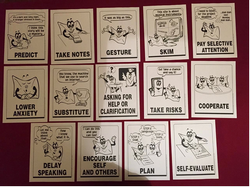In our center at ACCESS, Riverside School Board, we began a pilot project, which offers students weekly workshops to teach them different strategies on “how to learn”. In these workshops, students are being introduced to a variety of reading, writing, listening and communication strategies. Our ultimate goal is for students to effectively transfer language learnt in the classroom to be used in their everyday lives. Throughout the semester, teachers have noticed obvious success in the understanding and communication of students who had been attending the workshops. We have presented the Learning Strategies Project to the teachers at our center to integrate the learning strategies instruction with regular classroom lessons.
In order to teach strategies effectively, there are four critical steps a teacher must take ; name the strategy, explain how it will help students, describe when and how to use it, and model the strategy. It is important to give the strategy a name and explain what it means. For example, a teacher may say to the class, “Today, we will be using a strategy called predicting. Predicting means making a guess about what you think will happen”. By naming the strategy, we are making students conscious about what they are doing which increases the likelihood of them being able to use it again in a similar context. For example, the teacher may have a discussion with the class about how making predictions activates prior knowledge about the topic and increases understanding by putting them in a particular mindset. Next, we need to describe when to use the strategy and how it is used. We do this by making guesses in our mind based on previous knowledge and experience about the portrayal of the story. Effective learners often use this strategy without being aware. The problem with this is that the strategy is being used unconsciously and for that reason, it is more difficult to emulate the strategy again in a similar situation. When teachers model the strategy explicitly, students begin to use the strategy consciously and develop a better understanding of how to use it. For example, to teach students how to predict, the teacher could show the class the cover of a book or magazine and ask them to make predictions regarding what the story will be about based on the title and pictures. While students are expressing their ideas, the teacher could write all their predictions, in note form, on large chart paper at the front of the class. It is also helpful to point out any key vocabulary that may be important to the understanding of the story. After modeling this method a few times, it is helpful to slowly scaffold students to be able to use this strategy on their own. The teacher could encourage the students to make predictions orally as a class but this time without writing down their ideas. Then students can make predictions orally in small groups and eventually on their own : first written and finally mentally.
In conclusion, using strategies has proven to be highly effective when learning a new language. Consequently, the ultimate goal for this Learning Strategies Project is to motivate language teachers to provide explicit and embedded strategy instruction to their daily lessons since teaching strategies and techniques on “how to learn” facilitates the learning process and has highly positive results.
Lindsay Harrat et Faridey Raygani, Centre Access, CS Riverside





